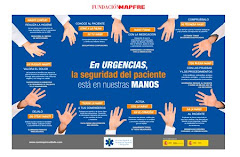Lectura recomendada:
Publicado hoy 29 de agosto en New England:
SEVERAL SEPSIS AND SEPTIC SHOCK
Acceso al documento completo: link
jueves, 29 de agosto de 2013
lunes, 26 de agosto de 2013
¿Qué se ha publicado sobre Seguridad del Paciente en los Servicios de Urgencias españoles ?. Relación de artículos publicados en Emergencias (2008-2013)
EVADUR:
eventos adversos ligados a la asistencia en los servicios de urgencias de
hospitales españoles. Tomás Vecina S, ChanovasBorràs MR, Roqueta F, Alcaraz J, Toranzo T .
Gestión de la seguridad del
paciente en una unidad de urgencias de atención primaria Orellana Carrasco R, ZájaraPorras M, Shevnina N, Rojas Quero M, Báez Cabeza A, Pérez-Montaut Merino I Emergencias. 2009;21:415-421
Higiene de manos en urgencias: grado de cumplimiento, determinantes y su evolución en el tiempo. Sánchez-Payá J,Hernández-García I, Camargo Ángeles R, Villanueva Ruiz CO, Martín Ruiz AC,Román Cerdá F, García Shimizu P, Llorens Soriano P
Evaluación de la anamnesis farmacoterapéutica realizada en el servicio de urgencias al ingreso hospitalario. Iniesta Navalón C, UrbietaSanz E, Gascón Cánovas JJ, Madrigal De Torres M, Piñera Salmerón P
La seguridad en los servicios de urgencias. Bañeres J
Programa
de intervención farmacéutica en el servicio de urgencias para mejorar la
seguridad del paciente. Tomás Vecina S, García SánchezL, Pascual Arce B, Riera Paredes I
sábado, 3 de agosto de 2013
Effect of daily chlorhexidine bathing on hospital-acquired infections
N Engl J Med. 2013 Feb 7;368(6):533-42. doi: 10.1056/NEJMoa1113849.
Effect of daily chlorhexidine bathing on hospital-acquired infection.
Climo MW, Yokoe DS, Warren DK, Perl TM, Bolon M, Herwaldt LA, Weinstein RA, Sepkowitz KA, Jernigan JA, Sanogo K, Wong ES.
Source
Abstract
BACKGROUND:
Results of previous single-center, observational studies suggest that daily bathing of patients with chlorhexidine may prevent hospital-acquired bloodstream infections and the acquisition of multidrug-resistant organisms (MDROs).
METHODS:
We conducted a multicenter, cluster-randomized, nonblinded crossover trial to evaluate the effect of daily bathing with chlorhexidine-impregnated washcloths on the acquisition of MDROs and the incidence of hospital-acquired bloodstream infections. Nine intensive care and bone marrow transplantation units in six hospitals were randomly assigned to bathe patients either with no-rinse 2% chlorhexidine-impregnated washcloths or with nonantimicrobial washcloths for a 6-month period, exchanged for the alternate product during the subsequent 6 months. The incidence rates of acquisition of MDROs and the rates of hospital-acquired bloodstream infections were compared between the two periods by means of Poisson regression analysis.
RESULTS:
A total of 7727 patients were enrolled during the study. The overall rate of MDRO acquisition was 5.10 cases per 1000 patient-days with chlorhexidine bathing versus 6.60 cases per 1000 patient-days with nonantimicrobial washcloths (P=0.03), the equivalent of a 23% lower rate with chlorhexidine bathing. The overall rate of hospital-acquired bloodstream infections was 4.78 cases per 1000 patient-days with chlorhexidine bathing versus 6.60 cases per 1000 patient-days with nonantimicrobial washcloths (P=0.007), a 28% lower rate with chlorhexidine-impregnated washcloths. No serious skin reactions were noted during either study period.
CONCLUSIONS:
Daily bathing with chlorhexidine-impregnated washcloths significantly reduced the risks of acquisition of MDROs and development of hospital-acquired bloodstream infections. (Funded by the Centers for Disease Control and Prevention and Sage Products; ClinicalTrials.govnumber, NCT00502476.).
Suscribirse a:
Entradas (Atom)








